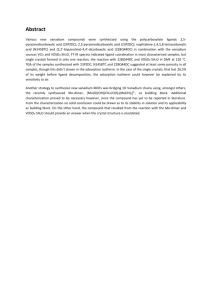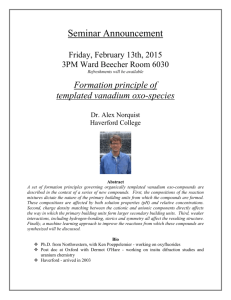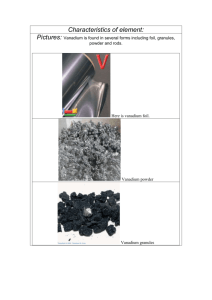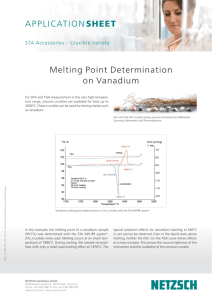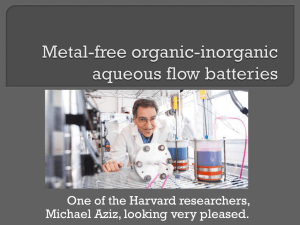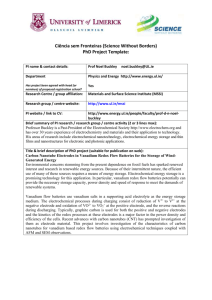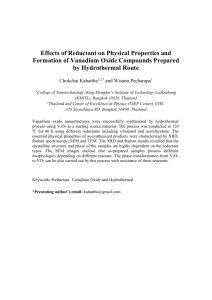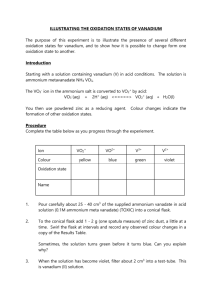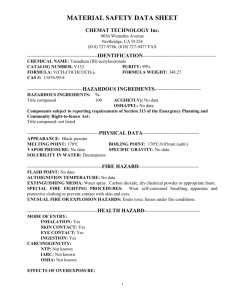Vanadium (revised)
advertisement
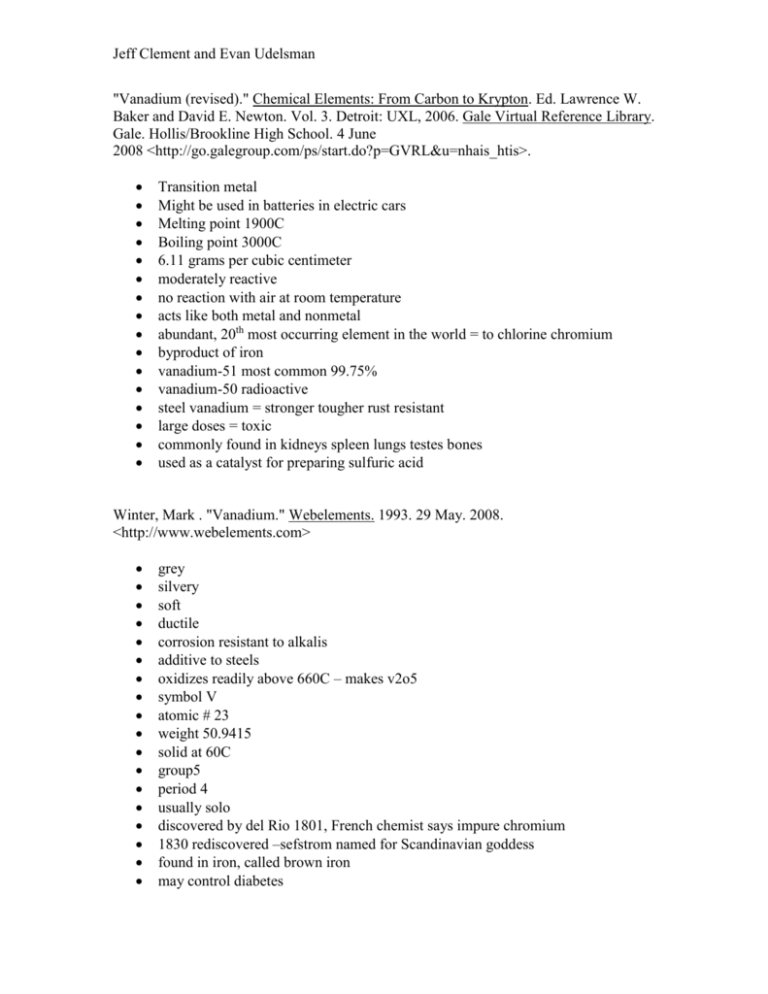
Jeff Clement and Evan Udelsman "Vanadium (revised)." Chemical Elements: From Carbon to Krypton. Ed. Lawrence W. Baker and David E. Newton. Vol. 3. Detroit: UXL, 2006. Gale Virtual Reference Library. Gale. Hollis/Brookline High School. 4 June 2008 <http://go.galegroup.com/ps/start.do?p=GVRL&u=nhais_htis>. Transition metal Might be used in batteries in electric cars Melting point 1900C Boiling point 3000C 6.11 grams per cubic centimeter moderately reactive no reaction with air at room temperature acts like both metal and nonmetal abundant, 20th most occurring element in the world = to chlorine chromium byproduct of iron vanadium-51 most common 99.75% vanadium-50 radioactive steel vanadium = stronger tougher rust resistant large doses = toxic commonly found in kidneys spleen lungs testes bones used as a catalyst for preparing sulfuric acid Winter, Mark . "Vanadium." Webelements. 1993. 29 May. 2008. <http://www.webelements.com> grey silvery soft ductile corrosion resistant to alkalis additive to steels oxidizes readily above 660C – makes v2o5 symbol V atomic # 23 weight 50.9415 solid at 60C group5 period 4 usually solo discovered by del Rio 1801, French chemist says impure chromium 1830 rediscovered –sefstrom named for Scandinavian goddess found in iron, called brown iron may control diabetes Jeff Clement and Evan Udelsman big dosages = stomach craps diarrhea and a green tongue "Vanadium" Potassium to Zirconium 2002 important to birds – stunts growth because of colors of oxidation, used in dying 4 oxidation states. With acids, oxidation sate 5 = yellow 4= blue 3= green 2= violet shell pattern 2-8-11-2 found in, Colorado, mexico, new mexico, utah, Arizona, peru used in x-rays/ synthetic rubber "One Smart Window." Today's Science On File Oct. 2004. Today's Science. Facts On File News Services. 4 June 2008 <http://www.2facts.com>. vanadium dioxide, special properties semi conductor heat passes throught ill certain temperature at certain temp, reflects heat. Adding stuff like tungsten can change the temp. Ex. 1.9% tungsten – reflect at 84 F Contact with beryl turns green, making an emerald. "Vanadium." The World Almanac Encyclopedia. Facts On FIle News Services. 3 June 2008 <http://www.2facys.com> vanadium is a metallic element the symbol for vanadium is "V" is a part of the transition elements in group five element number 23 vanadium melts at the temperature of 1890 degrees C (3434 degrees F) vanadium was discovered in the year 1801, by a Mexican man, Andres Manuel de Rio at first, vanadium was mistaken as chromium because it has similar properties and characteristics so vanadium was rediscovered and recognized as it own element in about 1830, by a Swedish chemist named Nils Gabriel Sefstrom vanadium is a silver-white metal it is also one of the hardest metals of them all vanadium is soluble in nitric and sulfuric acids, and insoluble in hydrochloric acid, dilute sodium hydroxide, and dilute alcohol vanadium has the ability to form several different types of acidic oxides, a few of the most important being the dark green trioxide and the orange pentoxide Jeff Clement and Evan Udelsman some other very important compounds that vanadium is included in are, vanadium monosulfide, vanadium dihydroxide, and metavanadic acid vanadium is the nineteenth element in abundance of the earths atmosphere it hasn’t been found pure or alone yet, but it is found combined with other metals in the early 1980s, the united states exported about twelve percent of the worlds annual amount of vanadium. Russia and South Africa also exported large amount of vanadium vanadium is used in many alloys because of its hardness and great tensile strength some alloys that vanadium is found in are, nickel vanadium and chromevanadium chrome- vanadium metal are very useful, they are used in springs, gears, and many engine parts titanium-vanadium alloys are also often used, they are used for some things such as missile cases, jet-engine containers, and nuclear reactors components vanadium has replaced platinum as a the most used metal used for the manufaction of sulfuric acid vanadium is also widely used for the development of photographs another common use is a drier in various paints The Vanadium Advantage. Environmental Health Perspectives. Volume 115; Page A 359- A 361. July 2007. Wind is the fastest growing source of energy in the US after natural gas. according to the World Watch Institute, wind power grew about the equivalent of 104 power plants (enough power to serve 5.2 million US homes) as of december 2006, total world wide wind capacity was at 74 gigawatts wind power is also an energy source that doesn’t emit any green house gas emissions now, experts are looking into vanadium redox-flow batteries (VRBs) VRBs can make wind power grow to the next level by increasing the tier capacity there are already power plants using the assistance of VRBs, in Vancouver and British Columbia also, as of May 2007 it has been announced that the Australian government is investing AUS$1.83 million dollars (1,553,536 US dollars) towards the deployments of VRBs in remote communities across the nation The invention of the VRB occurred at the University of New South Wales, in the early 1980s the VRB battery has the ability to store large amounts of energy for a small price, this is why the Vanadium redox-flow battery is so helpful on king island, VRBs have boosted wind power from 12% to 40% fo the total populations power it has also reduced net diesel emissions by about 46% (or 2000 tons annually) the VRBs most toxic component is the sulfuric acid in the electorlyte, but this is only one third as acid and harmful as the lead-batery and other batteries Jeff Clement and Evan Udelsman VRBs are unusable for cars though (for now) vanadium has a very low toxicity rate, so it doesn’t have a strong environmental foot print new car batteries still in the invention process will almost double the wattage power of a current hybrid car battery there are too many variables to calculate the money saved by the energy stored by new VRBs, but there will be a decrease in cost wind and VRBs have the potential to provide the majority of all electrical consumption VRBs will reduce the dependency on fossil fuels and other climate concerns VRBs can save the world just in time Thwaities, Tim. "A Bank For the Wind." MAS Ultra- School Edition: New Scientist, 1/13/2007. with vanadium being used in VRBs, we can store large amounts of energy and use it only when we need it King Island uses VRBs as a main resource for power King Island doesn't receive any energy from the main land (Australia), so the island relies on their own wind farm for energy King Island also recently received (2003) and installed a new lartge rechargeable battery, that stores unused wind energy to save as much wind as possible and none goes to waste this new rechargeable battery saves a lot of money and at least 2000 tons of carbon dioxide emissions A VRB (redox-flow battery) also can expand storage capacity, and a cheap cost oil and coal companies receive a greater demand for electricity in different parts of the year, like winter. But with a flow battery, extra electricity power saved up from the summer can be used in the winter and with fossil fuels, supply and demand is hard to keep up with and satisfy, this can be seen with today’s gas prices flow batteries also seem to have the ability to satisfy a broad range of electricity needs. (small needs in the summer to large needs in the winter) installation of this new flow battery on King Island took place in the 1980s, and it was installed by an Australian chemical engineer, Maria Skylla-Kazacos VRBs were invented in the University of New South Wales, but they are now being produced and sold by VRB Power Systems in Vancouver, Canada flow batteries are more expansive than other batteries currently being sold, but flow batteries will ultimately cost less, with the amount of energy that doesn’t go to waste and flow batteries might run cheaper is they begin to become more popular VRBs are also being used in electric cars, with this, drivers one day can fill their cars up with energized electrolytes, and the spent solution can be recycled
